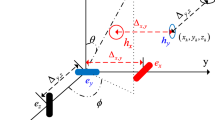Abstract
This paper developed a uniform Y-shaped array (UYA) in a 3-dimensional (3-D) environment. While introducing electromagnetic vector sensor (EVS), the closed-form expression of spatial fading correlation (SFC) was derived. The SFC was expressed in terms of azimuth and elevation angles of arrival and the geometry of an antenna array. The developed SFC can be used to determine the covariance matrixes at both transmitter and receiver hence the capacity can be calculated in a specific channel state. This paper studied on the performance of azimuth and elevation angles of arrival, azimuth spread and elevation spread on the SFC and the capacity of a multiple input multiple output (MIMO) system. The performance comparison between antenna arrays while introducing EVS and the traditional scalar sensor array (SSA), as a uniform Y-shaped array and a uniform circular array (UCA), were made. Simulation results showed that comparing to SSA, the antenna array which introducing EVS had a significant advantage and, UCA and UYA both had its own superiorities. This investigation expanded the application of statistical channel model and optimized the study of terminal antenna array.













Similar content being viewed by others
References
Damnjanovic, A., Montojo, J., Wei, Y., et al. (2011). A survey on 3GPP heterogeneous networks. IEEE wireless communication on Wireless Communications, 18(3), 10–21.
Adachi, F., & Ohno, K. (1991). BER performance of QDPSK with postdetection diversity reception in mobile radio channels. IEEE Transactions on Vehicular Technology, 40(1), 237–249.
Buyukcorak, S., & Kurt, G. K. (2011). Simulation and measurement of spatial correlation in MIMO systems with ray tracing. In IEEE 5th International Conference on Signal Processing and Communication Systems (ICSPCS), pp. 1–5.
Petrus, P., Reed, J. H., & Rappaport, T. S. (2002). Goematrical-based statistical macrocell channel model for mobile environment. IEEE Transactions on Communications, 50(3), 495–502.
Zhou, J., Qiu, L., et al. (2012). Analyses and comparisons of geometrical-based channel model arisen from scatterers on a hollow-disc for outdoor and indoor wireless environments. IET Communications, 6(17), 2775–2786.
Kyritsi, P., Cox, D. C., Valenzuela, R. A., et al. (2002). Effect of antenna polarization on the capacity of a multiple element system in an indoor environment. IEEE Journal on Selected Areas in Communications, 20(6), 1227–1239.
Shin, H., & Lee, J. H. (2003). Capacity of multiple-antenna fading channels: Spatial fading correlation, double scattering, and keyhole. IEEE Transactions on Information Theory, 49(10), 2636–2647.
Zhou, J., Sasaki, S., Muramatsu, S., et al. (2003). Spatial correlation for a circular antenna array and its applications in wireless communication. IEEE Global Telecommunications Conference, 2, 1108–1113.
Tsai, J. A., Buehrer, R. M., et al. (2004). BER performance of a uniform circular array versus a uniform linear array in a mobile radio environment. IEEE Transactions on Wireless Communications, 3(3), 695–700.
Ioannides, P., & Balanis, C. A. (2005). Uniform circular and rectangular arrays for adaptive beamforming applications. IEEE Antennas and Wireless Propagation Letters, 4, 351–354.
Takada, J. I. (2008). Impact of Concentrated Azimuth Power Spectrum for Performance Evaluation of User Terminal Array Antenna. Impact of Concentrated Azimuth Power Spectrum for Performance Evaluation of User Terminal Array Antenna.
Yong, S. K., & Thompson, J. S. (2003). A 3-dimensional spatial fading correlation model for electromagnetic vector sensors. In IEEE The 6th International SYmposium on Proceedings In Antennas, Propagation and EM Theory. pp. 843–846.
Yong, S. K., & Thompson, J. S. (2005). Three-dimensional spatial fading correlation models for compact MIMO receivers. IEEE Transactions on Wireless Communications, 4(6), 2856–2869.
Goldsmith, A. (2005). Wireless communications. Cambridge: Cambridge university press.
Hajian, M., Coman, C., & Ligthart, L. P. (2006). Comparison of circular, Uniform-and non Uniform Y-Shaped Array Antenna for DOA Estimation using Music Algorithm. The 9th European Conference on Wireless Technology, pp. 143–146.
Pollock, T. S., Abhayapala, T. D., & Kennedy, R. A. (2003). Introducing space into MIMO capacity calculations. Telecommunication Systems, 24(2–4), 415–436.
Buehrer, R. M. (2002). The impact of angular energy distribution on spatial correlation. IEEE 56th Vehicular Technology Conference, 2, 1173–1177.
Zhou, J., & Qiu, L. (2013). Analysis of MIMO antenna array based on electromagnetic vector sensor (China). Journal on Communications, 34(5), 1–11.
Acknowledgments
The authors would like to thank the anonymous reviewers for their constructive comments, which greatly helped improve the paper. Here also acknowledge Professor Fumiyuki Adachi for his helps to finish this paper, Department of Electrical and Electronic Engineering, Tohoku University, Japan. This research was supported by the National Natural Science Foundation of China (No. 61372128 and 61471153) and the Scientific and Technological Support Project (Industry) of Jiangsu Province (No. 14KJA510001).
Author information
Authors and Affiliations
Corresponding author
Rights and permissions
About this article
Cite this article
Zhou, J., Wang, Y. & Kikuchi, H. Performance of a MIMO Y-Shaped Antenna Array with Electromagnetic Vector Sensors. Wireless Pers Commun 86, 1141–1158 (2016). https://doi.org/10.1007/s11277-015-2979-9
Published:
Issue Date:
DOI: https://doi.org/10.1007/s11277-015-2979-9




